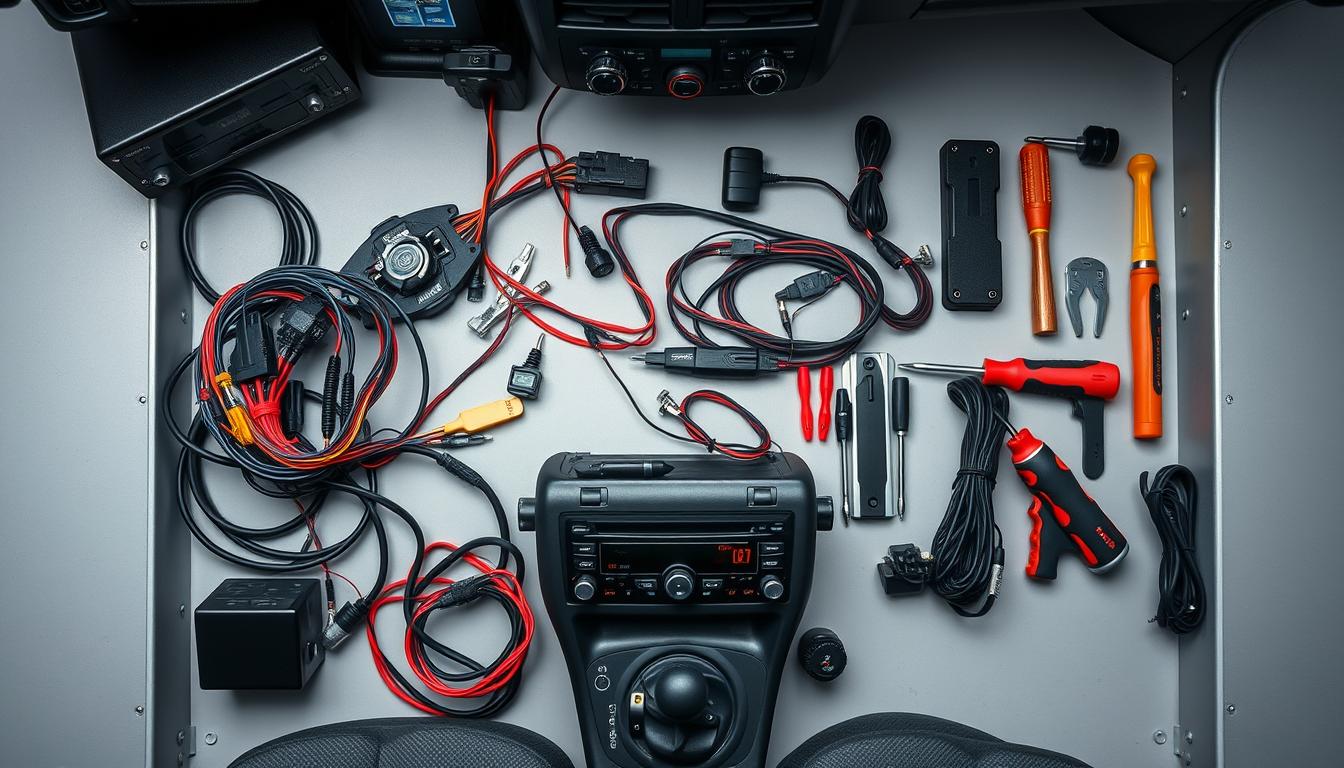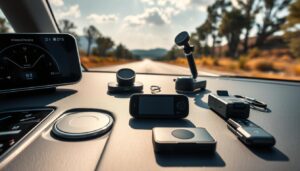How to Install a New Car Stereo System
Did you know 90% of drivers never use their vehicle’s full audio potential? Factory-installed units often lack the power and features modern listeners crave. Upgrading your setup unlocks crisp sound, hands-free calls, and seamless music streaming—transforming every drive into a personalized concert.
This guide simplifies the process of choosing and installing the right equipment for your needs. You’ll learn how touchscreen displays, Bluetooth pairing, and smartphone integration turn mundane commutes into immersive experiences. We’ll also explore how USB ports and SD card slots expand your entertainment options.
Safety is key. From disconnecting batteries to securing wiring, our tips help avoid costly errors. Whether you’re a DIY beginner or prefer hiring a pro, these steps ensure a clean, professional finish. Tools like trim removal kits and multimeters make the job smoother than you’d expect.
By the end, you’ll master everything from compatibility checks to final testing. Imagine cruising with studio-quality acoustics tailored to your taste—all without breaking the bank. Let’s dive into your audio upgrade journey!
Key Takeaways
- Modern upgrades offer Bluetooth, touchscreens, and smartphone integration
- Proper tool selection ensures safe and efficient installation
- Factory systems often underperform compared to aftermarket options
- Wiring organization prevents electrical issues and enhances aesthetics
- Compatibility research saves time and money before purchase
- Professional tips help achieve polished, long-lasting results
Understanding Car Stereo System Options

Modern drivers demand more from their in-vehicle entertainment than ever before. Whether you’re streaming playlists or navigating city streets, the right equipment makes all the difference. Let’s explore what’s available to transform your daily drives.
Form Factors That Fit Your Ride
Two main styles dominate the market today. Single din units work best for compact dashboards, measuring about 2″ tall. Their space-saving design suits older vehicles or those needing basic functionality.
Double din options double the height for 7″ screens or larger. These multimedia powerhouses display maps, album art, and climate controls simultaneously. The BCPA14 model’s 14″ display proves how far touchscreen tech has evolved.
Features That Match Your Budget
Entry-level players like the 656BCK bundle essentials: Bluetooth calls, USB ports, and crisp 6.5″ speakers. At under $100 during sales, they’re perfect for first-time upgraders. Mid-range picks add smartphone integration—the BCP62-RC brings wireless Apple CarPlay for under $200.
Premium receivers shine with theater-quality sound and wireless Android Auto. The BV6860BH stands out for RVs with its HDMI pass-through, while high-end models offer 4K video support. Remember:
- Screen size affects both visibility and installation complexity
- Wireless connectivity reduces cable clutter
- Multiple audio outputs future-proof your setup
Preparing for Installation
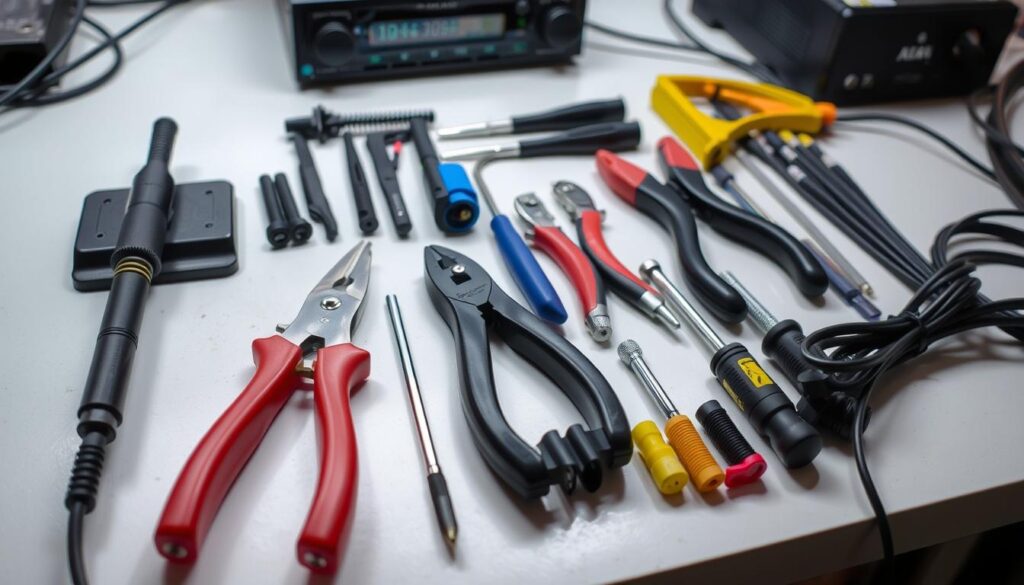
Upgrading your vehicle’s audio setup begins long before you touch a single wire. Smart planning now prevents headaches later—and helps you avoid those “why didn’t I…” moments halfway through the project.
Gathering the Right Tools and Materials
Start with basics: screwdrivers, trim removal tools, and wire strippers. The KIT20 wiring kit ($52.41) handles heavy-duty power needs, while the B25N noise filter ($14.55) silences unwanted hums. Don’t forget a steering wheel control interface—it keeps your original buttons functional.
Vehicle-specific dash kits ensure your new unit fits snugly. Factory wiring harness adapters are non-negotiable—they protect your electrical system and simplify connections. Always double-check fit guides for your make and model.
Safety and Pre-Installation Tips
Disconnect the battery first—always. Work in daylight or under bright LEDs to spot wire colors clearly. Lay out components like puzzle pieces before assembly.
Use plastic pry tools to remove panels without scratches. Label every disconnected cable with masking tape. “Surprise wiring configurations happen,” says veteran installer Marco Perez. “Photos of original setups save hours of troubleshooting.”
Ground loop isolators like the B65N ($16.07) boost sound clarity by 40% in most setups. Keep a multimeter nearby to test circuits—it’s cheaper than replacing fried electronics.
Step-by-Step Installation Guide
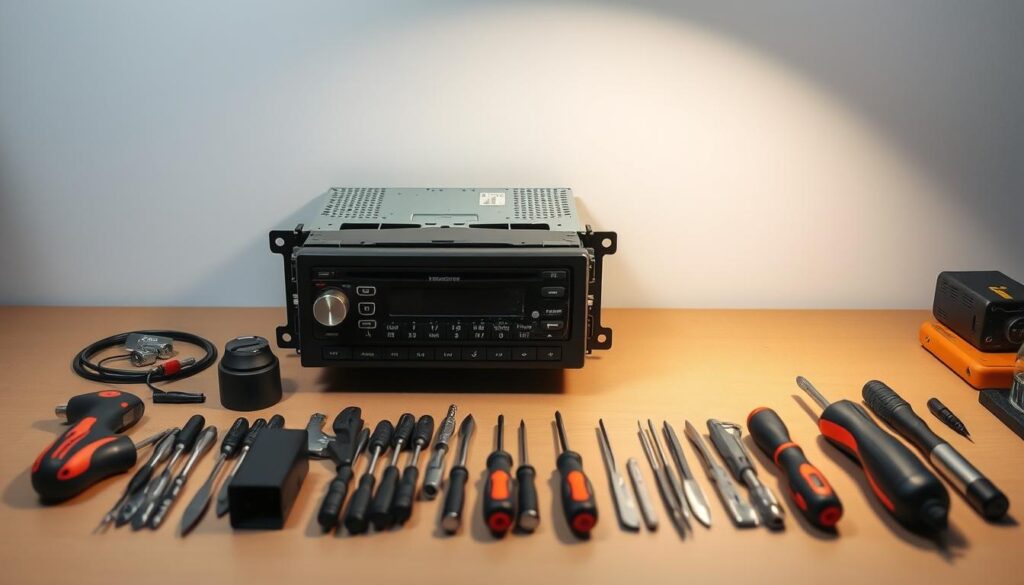
Transforming your ride’s audio begins with precision removal of outdated components. This phase demands focus—like solving a puzzle where each piece affects the final result. Let’s break down the process into manageable stages for smooth execution.
Removing the Factory Stereo
Start by locating hidden fasteners behind trim panels. Most dashboards use spring clips or Torx screws that require specialty tools. Gently pry faceplates with nylon spudgers to avoid scratches. “Rushing here costs $200+ in replacement parts,” warns audio technician Lisa Nguyen.
Wiring and Mounting Techniques
Match wire colors using a conversion chart—red for ignition power, yellow for constant 12V. Secure connections with heat-shrink tubing instead of electrical tape for durability. Test each circuit with a multimeter before final assembly.
| Tool | Purpose | Pro Tip |
|---|---|---|
| Trim Removal Kit | Prevents dashboard damage | Start from bottom edges |
| Wire Crimpers | Secure terminal connections | Twist strands clockwise first |
| Panel Popper | Releases hidden clips | Apply steady upward pressure |
Mounting brackets should align with factory screw holes—modify metal sleeves if needed. Leave 1/8″ clearance around vents to prevent airflow blockage. Double-check antenna adapters for FM/AM signal strength before closing panels.
Integrating Apple CarPlay and Android Auto
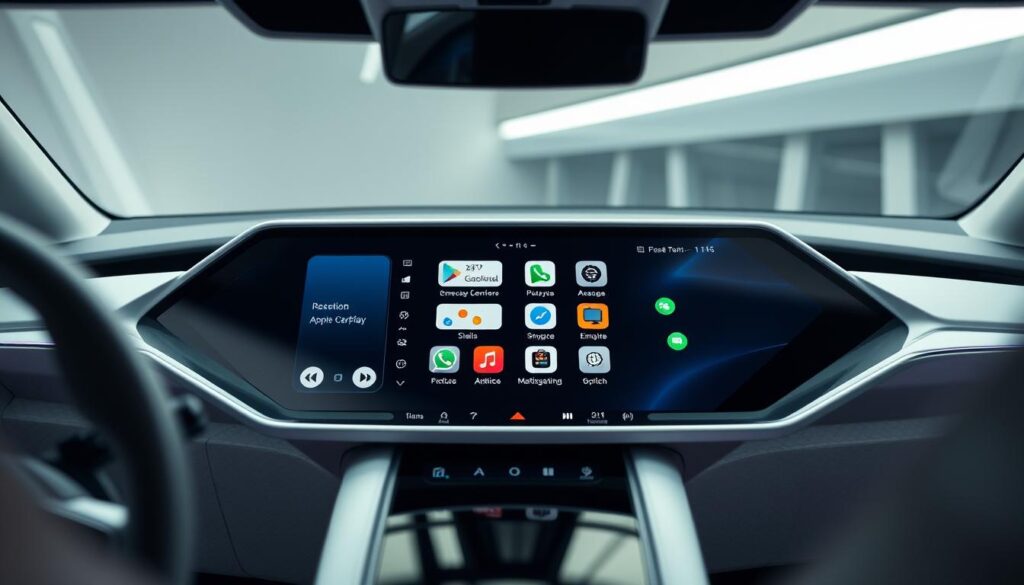
Smartphone integration revolutionizes how we interact with our vehicles. Modern units like the BVCPA10W ($426.35) and BCPA12 ($444.71) transform dashboards into command centers—accessing maps, playlists, and messages through familiar interfaces.
Wireless Freedom Showdown
Wireless Apple CarPlay eliminates cable clutter with automatic iPhone detection. Android Auto matches this convenience for Pixel and Samsung users—both systems activate within seconds of starting your engine. Key differences emerge in voice commands:
- Siri handles music requests and calendar updates
- Google Assistant excels at real-time traffic navigation
Seamless Pairing Process
First-time setup takes three steps:
- Enable Bluetooth on your phone
- Select your stereo’s network in device settings
- Confirm permissions on both screens
The BCPA8W’s 8″ display proves ideal for compact cabins, while 12″ models suit trucks and SUVs. “I never realized how much easier wireless could make my commute,” shares tech reviewer Jenna Collins. “Now my phone stays pocketed until arrival.”
Compatibility checks prevent headaches. Verify your device runs iOS 14+ or Android 10+—most 2020+ models qualify. Wired connections serve as reliable backups when wireless signals weaken in rural areas.
Optimizing Car Audio Experience
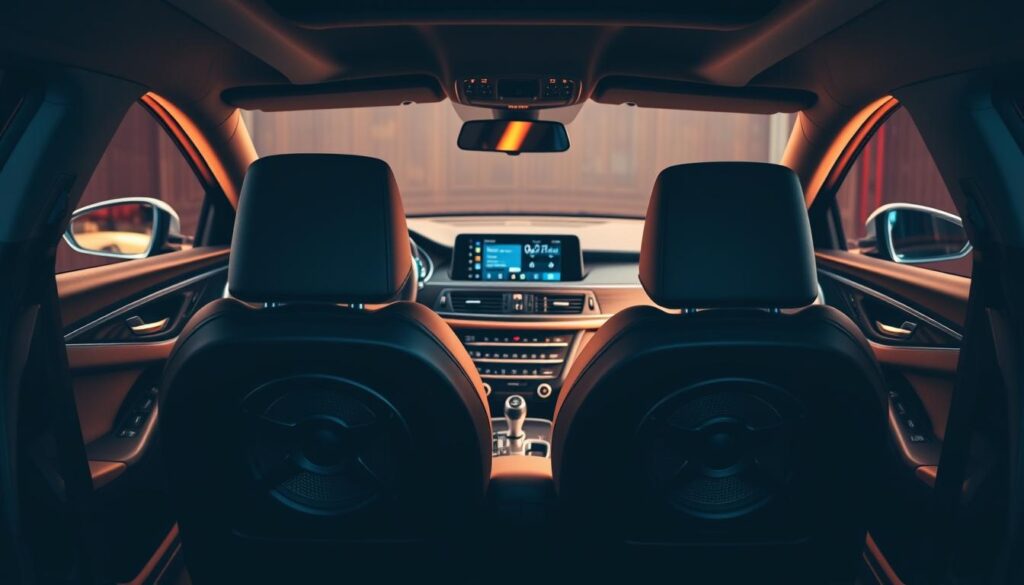
Your journey to premium sound doesn’t end with a new receiver. True audio bliss comes from balancing components like a symphony conductor. Let’s explore how to elevate every note and beat in your mobile listening space.
Power Boosters That Transform Sound
Amplifiers act as your music’s personal trainer. The R1004 4-channel model ($61.19) delivers 400 watts—enough to make factory components sing. For bass lovers, the AR3000D’s 3000-watt punch shakes seats without distortion.
Class A/B designs offer warm tones for jazz enthusiasts. Class D units excel in efficiency, keeping your battery happy during marathon drives. Always match amplifier outputs to your speakers’ power ratings—mismatches cause crackles or blown cones.
Crystal-Clear Upgrades Worth Hearing
Component sets like the CH6CK ($55.24) separate highs and lows through dedicated tweeters and crossovers. You’ll hear cymbal crashes as if you’re stage-side. Full-range CH6500 speakers ($21.41) simplify installation while boosting midrange clarity.
Polypropylene cones handle humidity better than paper versions. Silk dome tweeters reduce ear fatigue during long trips. “Proper speaker angling makes vocals float naturally around the cabin,” notes audio engineer Derek Mills.
Seal every connection with crimp caps—not tape—to prevent rattles. Run power cables away from signal wires to avoid static. Test each upgrade individually before full system checks. Your ears will thank you when every guitar strum feels live.
Customizing with Additional Components
Elevate your audio journey with enhancements that personalize every note. While quality speakers form the foundation, specialized add-ons let you sculpt sound to match your musical taste.
Adding a Subwoofer for Extra Bass
Powered models like the B12ES deliver room-shaking lows through built-in amplifiers. Its wireless remote lets you tweak bass levels mid-drive—perfect for switching between podcast clarity and concert-level thump.
Space-conscious options shine too. The BAB10’s slim profile fits under seats while pumping 1200 watts. Dual voice coil designs, such as the CXX124DVC, offer wiring flexibility for advanced setups. Match enclosure types to your vehicle’s acoustics—sealed boxes for tight punch, ported for resonant depth.
Proper installation preserves sound balance. Component subwoofers require separate amps but reward with studio-quality precision. Always check alternator capacity before connecting high-power units. A clean power supply prevents dimming lights during heavy drops.
Pro tip: Position your subwoofer near rear panels for natural bass reflection. Use rubber isolators to reduce trunk vibrations. With these upgrades, you’ll feel every beat as intended—transforming highways into front-row listening experiences.
FAQ
Can I install a new receiver without professional help?
What’s the difference between a double-din and single-din multimedia player?
Will upgrading my factory speakers improve sound quality?
Do wireless Apple CarPlay and Android Auto drain phone batteries faster?
How do I add a subwoofer to my existing audio setup?
Are aftermarket tweeters worth installing?
Can I keep my steering wheel controls with a new receiver?
Does Bluetooth affect sound quality compared to wired connections?

Adam Peter is a finance, travel, and automotive writer with over a decade of experience. He creates clear, practical content to help readers manage their money, explore the world with confidence, and make informed decisions about cars and travel gear. His work blends expert insight with real-world usefulness.

